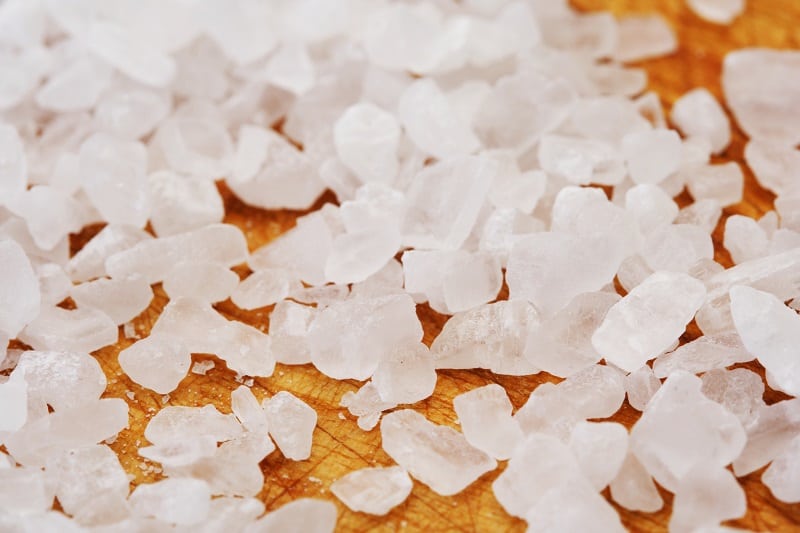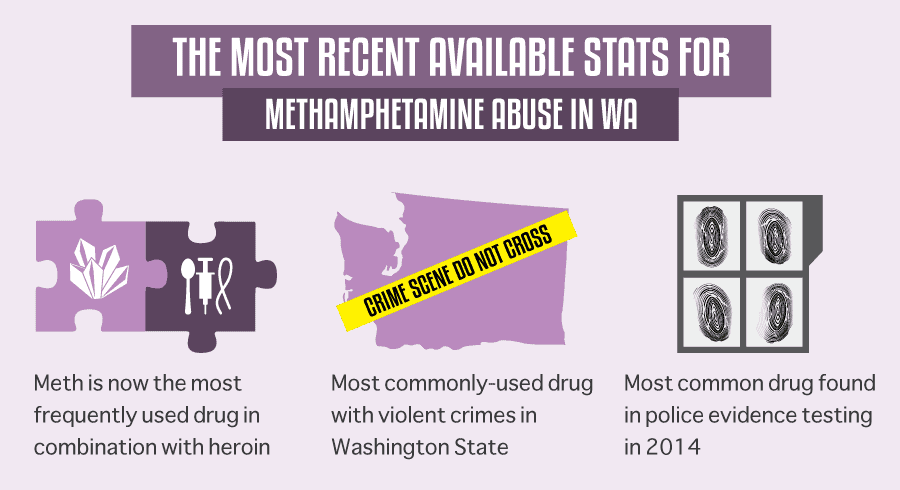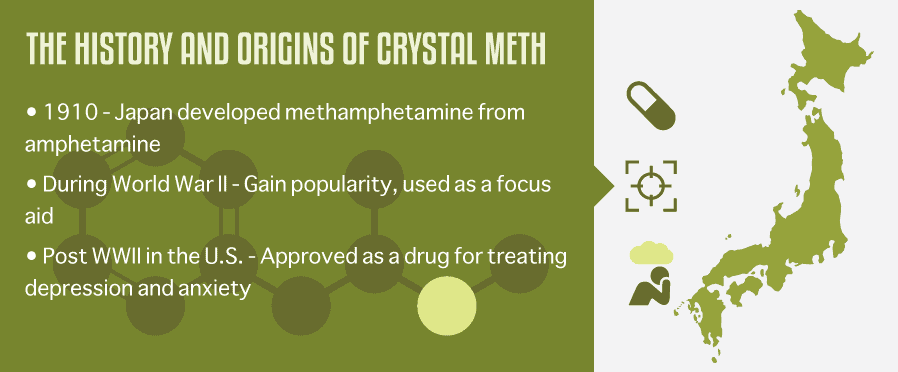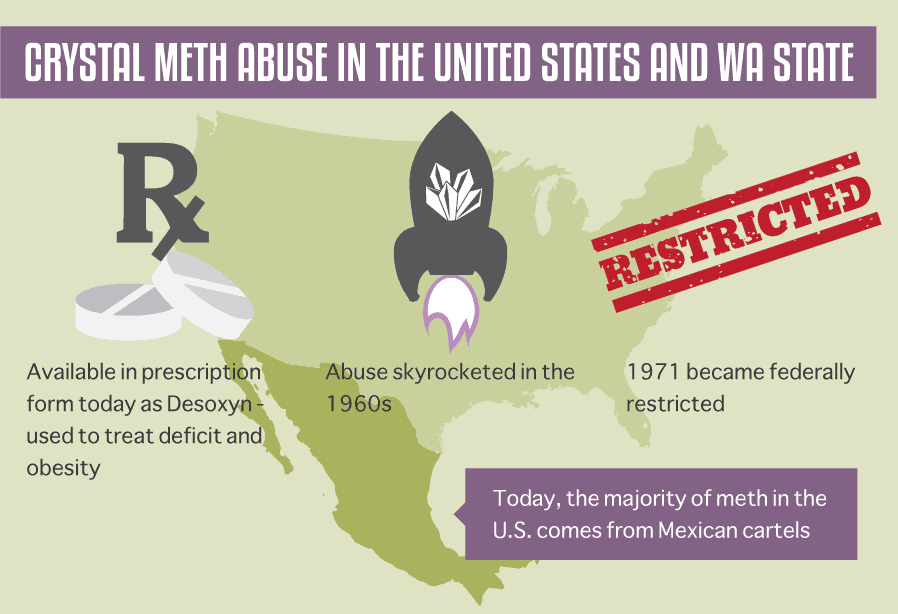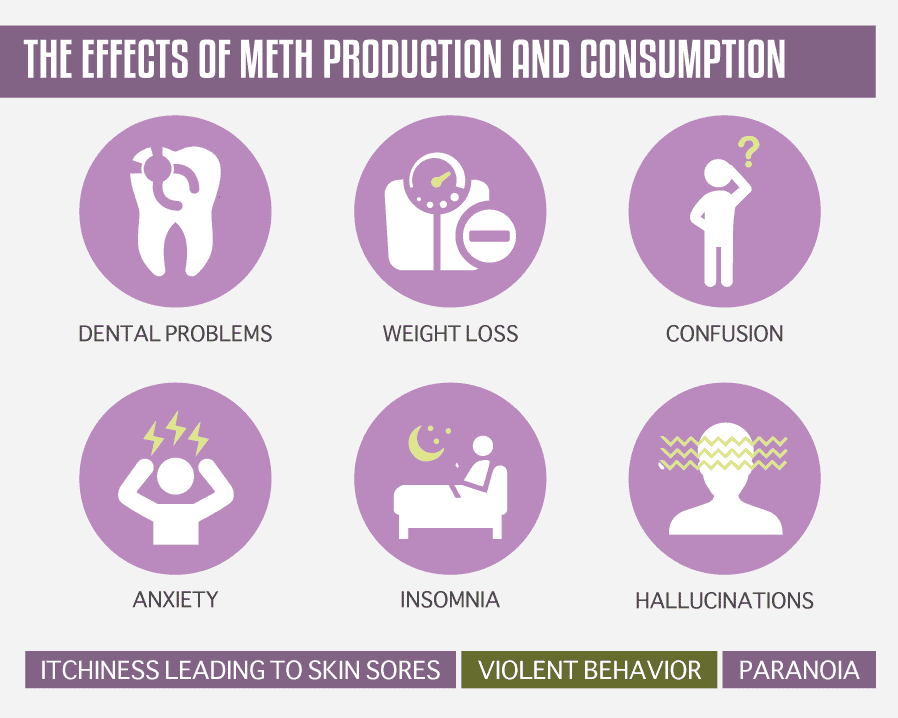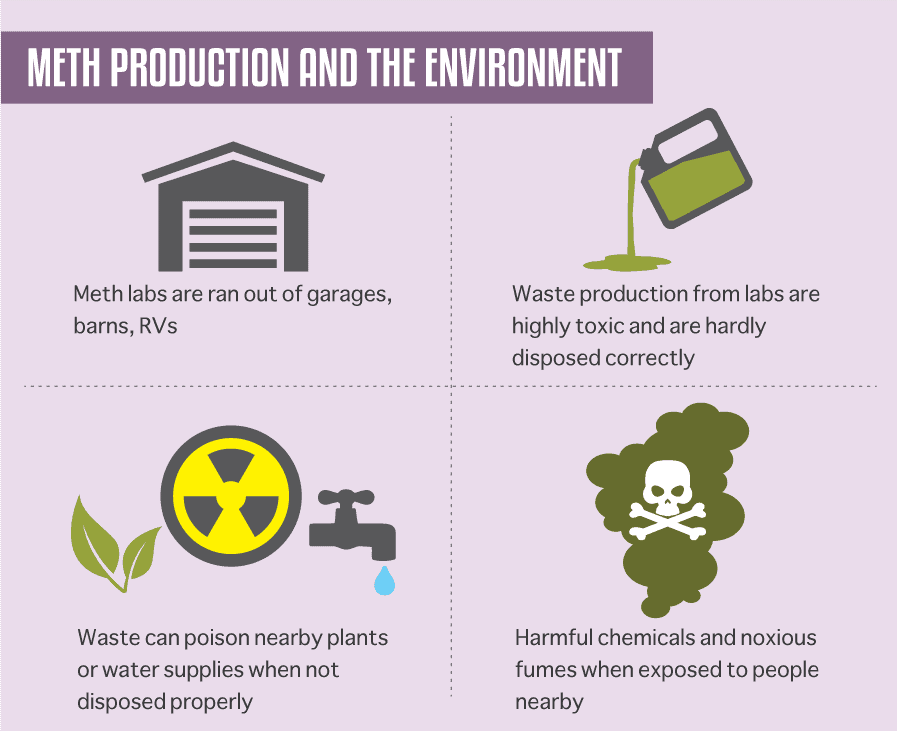Crystal meth abuse in WA state is on the rise, and it continues to trend up as a major problem around the world. The scourge of methamphetamine has quietly increased while so much attention is (deservedly) given to the rising opioid epidemic. But almost 14% of people in WA state have a problem with drug addiction, and the fact that meth isn’t the most prevalent drug problem in the country right now is no excuse to lose sight of it. Over a million Americans, thousands of them Washington residents, have abused meth at some point, and this epidemic is one that must be addressed just as seriously as the opioid crisis. If not, it threatens to simply replace opioids as the most damaging illicit drug in America. Methamphetamine is a stimulant known for increasing its user’s heart rate, energy level, and body temperature. It goes by the street name “speed” for this reason. It is a drug people take illicitly for a rush of dopamine, and the perception that they will get increased focus, energy, and even intelligence from the drug. In other words, it’s a drug that make its user feel “sped up.” There is some basis for this belief. Amphetamine, the progenitor of methamphetamine, is a chemically similar drug used for treating attention-deficit disorder, narcolepsy, and obesity. However, at proper doses, amphetamine use – even over long periods of time – is not known to be addictive or particularly harmful. The problem is that methamphetamine is a much stronger variant of of amphetamine, in much the same way heroin is known to be a stronger variant to morphine. The illicit, recreational use of methamphetamine is far more common than the legal, regulated use of amphetamine. In addition, unregulated recreational use of methamphetamine tends to come at much higher doses. And at higher doses, it is much more likely to lead to drug tolerance, dependency, and addiction. So here is what we know about the latest trends in crystal meth use in the United States, and specifically in the state of Washington.
The Most Recent Available Stats for Methamphetamine Abuse in WA
Heroin and meth are the two drugs constantly jockeying for position as the most prevalent and damaging illicit drug in the Northwest, especially since marijuana can’t really be considered “illicit” in many states. Today, meth is the most commonly-used drug in combination with heroin, and is by far the most prevalent drug found in conjunction with violent crimes in the state of Washington. Theft and larceny are often most commonly associated with meth and heroin by law enforcement, far more than drugs like marijuana. Meth became the most common drug found in police evidence testing in the state of Washington for the first time ever in 2014. This is admittedly an incomplete assessment of how widespread the problem is, as it takes only a snapshot of what law enforcement has been able to find. However, it is a useful benchmark to show the increasing problem of meth, as well as law enforcement’s increased focus on it. Because drugs are illegally trafficked, it’s impossible to say for sure which ones are most prevalent outside of which ones have been discovered by police. The best hard statistics we have are those related to law enforcement, self-reporting, and medical and recovery attendance. Supplementing this is the fact that crystal meth is the second-most common drug mentioned in emergency calls in Washington. Treatment data helps fill in the blanks, but is also incomplete. Only a small percentage of people who need addiction help will actually get it. Furthermore, those who decide to get treatment are normally not new addicts. Typically, those who seek treatment have been addicted for several years, and only seek treatment once they’ve hit rock-bottom, after suffering irreversible consequences in their relationships, families, careers, and health. So in general, treatment statistics aren’t really an accurate snapshot of where meth abuse is right now, but rather where it has been in recent years. That’s why it’s far more useful to look at trends over time, as compared to single-year statistics.
The History and Origins of Crystal Meth
To give some context to these crystal meth abuse numbers, it’s important to know how the meth trade has evolved over the years. Japan is actually the country responsible for developing methamphetamine from amphetamine in the 1910s, and it began to see widespread use as a focus aid during World War II. Most notably, Japanese fighter pilots would often be given the drug before a mission to heighten their focus. Ground forces would often be given to troops to keep an alerted state during periods of calm. Methamphetamine spread gradually from there, taking root in the post-World War II United States as a legal, medically-approved drug used to treat depression and obesity. As the medically-approved uses of the drug expanded, so too did non-medical uses related to improving academic and athletic performance.
Crystal Meth Abuse in The United States and WA State
Abuse of crystal meth spiked in the 1960s (along with a number of other illicit drugs), leading to it being federally restricted for use in 1971. Despite that, it is currently available today in prescription form, under the name Desoxyn. Desoxyn is a pill that is actually used in the same way that methamphetamine historically has – treating attention deficit and obesity. Demand for crystal meth remained high even after being banned in 1971, so production was generally gang-controlled over the next two decades, until larger drug trafficking organizations in Mexico and the Southwest took control and began to expand the development, production and distribution of methamphetamine, making it into a major industry instead of a smaller-time operation The majority of methamphetamine in the United States today comes via Mexican cartels. This actually helps to explain why meth production has ramped up so much in recent years. With states like Washington, Colorado, and others moving to legalize recreational marijuana, drug cartels have seen their profits take a huge hit, as the demand for illicit marijuana has bottomed out. In response, they have doubled-down on the production of other illicit drugs, with meth and opium topping the list.
The Effects of Meth Production and Consumption
While the majority of methamphetamine in the United States comes from major production factories in Mexico, there is still a large number of smaller meth labs across the United States. In fact, an amendment to the Patriot Act in 2005 is the reason certain over-the-counter medications were limited, to help limit the production of meth in America. That’s why you can only buy one box of Sudafed at a time now – because it contains psuedophedrine, a decongestant that happens to be a key ingredient in the creation of crystal meth. Unfortunately, that provision has served little purpose but to inconvenience cold sufferers, as meth production and consumption has skyrocketed since 2005. In fact, the meth that is being developed in the wake of that legal change has actually increased from around 50 percent to around 80 percent, making it even more addictive and dangerous. All this means is that the meth industry is sophisticated enough to find different supply lines. It is still being produced at a blistering pace, and at an even higher degree of quality than before. The effects of extended methamphetamine abuse are well-documented and may include:
- severe dental problems
- dangerous weight loss
- itchiness leading to skin sores
- anxiety
- confusion
- insomnia
- violent behavior
- paranoia
- hallucinations
The dental problems with meth are not limited to oral methods of using the drug. In fact, “meth mouth” is most common in those who inject the drug.
Meth Production and the Environment
While we often talk about the effects of meth on the human body, what isn’t often discussed is the environmental effects of meth production. These meth labs – often run out of a garage, barn, or other outbuilding – generally use some highly-volatile ingredients in the creation of crystal meth. The waste from the production of crystal meth – which often involves substances like brake cleaner, ammonia, glass bottles, cat litter, antifreeze, lithium batteries, and matches – is highly toxic, and is rarely disposed of properly. Waste like this can be a sure sign of a meth lab, and can also poison nearby plants or water supplies when disposed of improperly. Because the substances used in meth creation are so volatile, the labs that create them are subject to explosions if not run properly. In addition to extensive property damage, this can also expose people nearby to harmful chemicals and noxious fumes.
Getting a Handle on Meth Addiction in Washington State
Addiction is a nasty disease that really doesn’t play favorites, and meth is a growing menace in the fight against meth addiction, with meth addiction treatment. While the majority of headlines about drug prevention continue to focus on stopping opioids, meth stands in the shadows as a serious problem that needs to be addressed. Meth attacks the brain in the same way any other addictive substance does – by making you feel a rush of artificial happiness, and then convincing you it’s not only real, but necessary. It’s like bait leading you into a cage – you’re drawn in by something you enjoy, unsuspecting, but then once you realize what’s happened, you’re trapped. It’s important to know that this isn’t your fault. What is happening is that your brain has been chemically altered, and is now geared to put meth as your top priority, regardless of the consequences. When you take meth, your brain is flooded with dopamine. Dopamine is the hormone that basically makes you feel good for doing something. When you exercise, or accomplish a difficult task, eat great food, or engage in a hobby you love, you get a healthy dose of dopamine, which is basically your brain’s way of telling you, “good job, do that more often.” It’s a feeling that makes you happy. Meth takes this feeling and sends it into overdrive. Rather than a healthy, sustainable dose of dopamine, it floods your brain with it. The result is that you feel absolutely euphoric, but then your body begins to adapt and develop tolerance to those dopamine rushes. Eventually, you need larger and larger doses to get the same result. Soon, the things that used to make you happy no longer do. The normal, healthy doses of dopamine that you get from hobbies and other things you enjoy don’t even register as entertaining or enjoyable anymore. You’ve become so dependent on drugs that the only way you can get that feeling of happiness is to keep using meth. Eventually, even the rush from the meth will wear off, and you’ll need higher and higher doses to feel that rush. This vicious, rising cycle of abuse inevitably leads to a higher and higher risk of overdose. It is imperative that you get treatment before that happens. Whether you’re addicted to meth, heroin, alcohol, or something else entirely, there is always help. Drug rehab centers in Washington exist to get you back on your feet and free of that controlling influence in your life. Have you ever struggled with meth in Washington State? Leave us a comment below.
What Did you Think About This Blog?
Give it a Rating!
Full Infographic:


